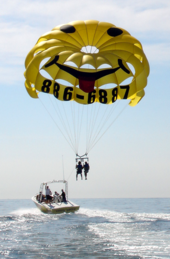Water sport is, in its broadest sense, all kinds of recreation in, or on, a body of water, typically at a beach.
In some countries the shoreline is regarded as public, even when landowners normally can restrict entry to their lands. In the Nordic countries, the right of access generally gives access to the shore, except by people's homes and cottages. But there are also countries where swimming is restricted to organized beaches.
Water sport
[edit]
Swimming and diving
[edit]- Scuba diving
- Snorkeling
- Snuba
- Swimming
- Winter swimming
Boating and surfing
[edit]Other
[edit]Respect
[edit]There are several precautions for everyone approaching open water, whether for a casual dip, or a long-distance swim.
- Respect laws and customs for clothing. Each country has its own acceptable level of nudity; naturism is, in the typical case, an exception.
- Respect wildlife: See animal ethics.
- Don't litter. Ideally, leave no trace.
Stay safe
[edit]- Main article: Water safety

Swimming and other water-related activities can be dangerous. The following are water-related dangers:
- Rip currents happen when waves break off a beach. Deaths result from rip currents because people try to swim against these currents, and as a result get exhausted. It is better to swim parallel to the shore or let the current take you (while calling for help) so you do not get exhausted. Once you get away from the current, you can swim to shore normally. Do not go to areas where you know rip currents take place.
- Drop-offs are where the underwater terrain changes suddenly.
- Fishing nets, submerged trees and other obstacles can result in hazards.
- Quicksand and other seabed features could get you caught in a particular place or pulled underwater.
- Jellyfish, sharks and other wildlife can be dangerous.
- Tsunamis and storms can be even more dangerous if you're at the beach than if you're inland.
Get local advice before visiting a beach you don't know well.
When at the beach, watch children and swim in pairs so no-one drowns; be careful with floating devices, with the exception of lifebuoys. If you see someone disappear, watch closely where they disappear and call for help at the same time. Do not forget where the disappearance took place so you can direct help to the right place.
Unless you have rescue training or are rescuing a small child, always have some device between you and the victim; a person scared of drowning can drag you into the deep. Have a look for possible aids already when arriving: lifebuoys, oars, poles, surfboards etc.

